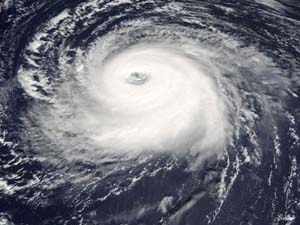Hurricanes blow, they rain, they flood, but seldom do they crackle
The boom of thunder and crackle of lightning
generally mean one thing: a storm is coming. Curiously, though, the biggest
storms of all, hurricanes, are notoriously lacking in lightning.

The boom of thunder and crackle of lightning generally mean one thing: a storm is coming. Curiously, though, the biggest storms of all, hurricanes, are notoriously lacking in lightning. Hurricanes blow, they rain, they flood, but seldom do they crackle.
Surprise: During the record-setting hurricane season of 2005 three of the most powerful storms–Rita, Katrina, and Emily–did have lightning, lots of it. And researchers would like to know why.
A hurricane’s winds are mostly horizontal, not vertical. So the vertical churning that leads to lightning doesn’t normally happen.
It’s tempting to think that, because Emily, Rita and Katrina were all exceptionally powerful, their sheer violence somehow explains their lightning. But Blakeslee says that this explanation is too simple. “Other storms have been equally intense and did not produce much lightning,” he says. “There must be something else at work.”
Well, don’t ask me. I just look for stuff to read — written by experts. So much of today’s science is so fascinating — in so many fields, specialties — I wonder how a young student begins to decide upon a discipline.
Posted: Wed - January 11, 2006 at 05:59 AM